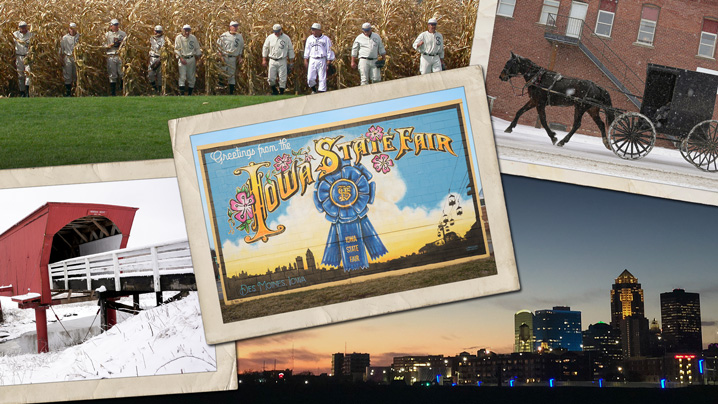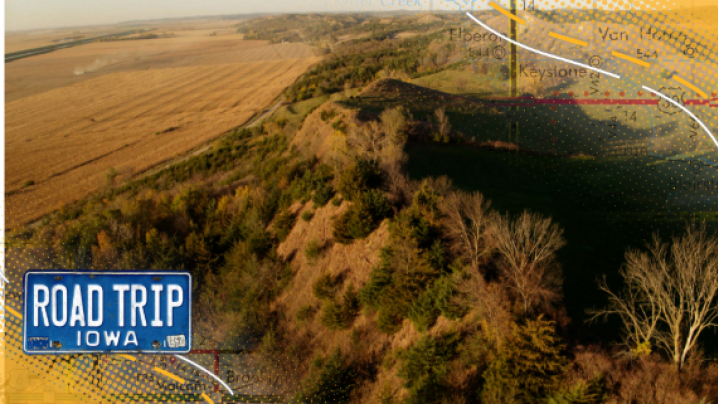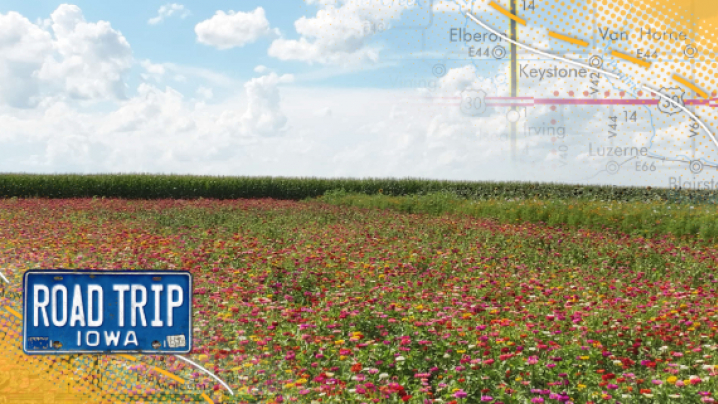Iconic America
Show Us Your Iconic Iowa (opens in new window)
View our growing collection of fan submissions of iconic Iowa imagery throughout the state and submit your own.
Iconic Iowa Photo Gallery
Roseman Covered Bridge, Winterset
Built in 1883, the Roseman Covered Bridge is one of the original 19 covered bridges in Madison County. Currently, there are only six. The bridge was added to the U.S. National Register of Historic Places in 1976.
Loess Hills, Honey Creek
The Loess Hills (pronounced Luss) stretch from Northwest Iowa all the way along down to Missouri along the Missouri River. The hills are a formation of wind-deposited Loess soil, formed shortly after the last Ice Age.
Black Hawk Bridge
The Black Hawk Bridge that spans the Mississippi River between Lansing, Iowa, and Crawford County, Wisc., is among the rarest of North American bridges. It is referred to as a singing bridge due to the sound car tires make as they cross the steel grate floor.
Grotto of the Redemption, West Bend
Believed to be the largest Grotto in the world, the Grotto of Redemption was built over the span of 42 years. It draws more than 100,000 visitors each year and was added to the U.S. National Register of Historic Places in 2001.
Iowa State Fair
The Iowa State Fair, often regarded as one of the best state fairs in the country, began in 1854 during a two-day event in Fairfield. Over the following two decades the location changed before permanently settling in Des Moines in 1886. The fairgrounds span 450 acres, which include the campground.
Robert D. Ray Asian Gardens
Along the northern edge of the Des Moines River, the Asian Gardens, featuring a large Asian pavilion and stone pagodas, serves as a monument to Iowa Gov. Robert D. Ray and his outreach efforts during the refugee crisis in the 1970s.
Maquoketa Caves State Park
One of Iowa’s most unique parks, the Maquoketa Caves State Park in eastern Iowa has more caves than any other park in the state. The park’s 16 caves vary in size, and while some are walkable, others can only be experienced by crawling. Hikers can enjoy a six-mile network of trails that lead to the caves, across a natural bridge, along the edge of scenic bluffs and around the 17-ton “Balancing Rock.”
American Gothic House
In 1930, shortly after visiting the town of Eldon to gather inspiration, Iowa artist Grant Wood was inspired by the gothic architecture of an upstairs window frame and used the house as a backdrop in a painting that would capture a global audience.
Iowa Capitol, Des Moines
Iowa’s state capital was moved to Des Moines in 1857, but the current building on Grand Avenue wasn’t completed until 1886. It is the only five-domed capitol building in the country. The bricks used in construction are all made out of limestone from Iowa.
Neal Smith Wildlife Refuge
Established in 1990, the Neal Smith Wildlife Refuge was established in an effort to restore and manage the native ecosystem of the tallgrass prairie. The 6,000-acre parcel of land offers educational and recreational opportunities, including five walking trails and a bike trail.
Amish in Iowa
The Amish have been in areas of Iowa well before the Hawkeye State was established in 1846. The first Amish to settle in the Iowa territory was in 1840, in what is now Lee County, and the oldest Amish settlement is Kalona, which was established in 1846.
ICONIC AMERICA
Behind the Scenes
Preview: Season 1 | 1m
David Rubenstein examines the history of America through some of its most iconic symbols, objects and places, on location and in conversation with historical thinkers, community members and other experts. Together, they dive deep into each symbol’s history and how its meaning has changed over time, using them as a gateway to understanding America’s past and present.
Upcoming Events
Road Trip Iowa: Loess Hills National Scenic Byway Advance Premieres
Road Trip Iowa: Lincoln Highway Heritage Byway West Watch Party
David Rubenstein examines the history of America through some of its most iconic symbols, objects and places, on location and in conversation with historical thinkers, community members and other experts. Together, they dive deep into each symbol’s history and how its meaning has changed over time, using them as a gateway to understanding America’s past and present.


